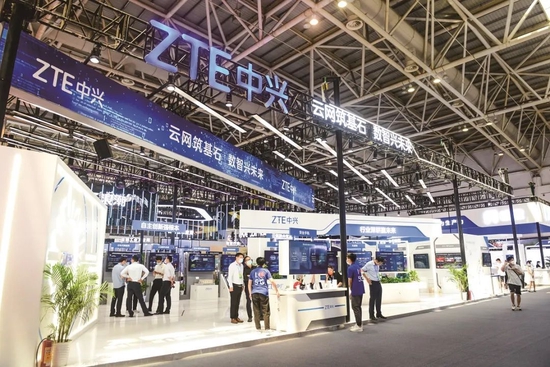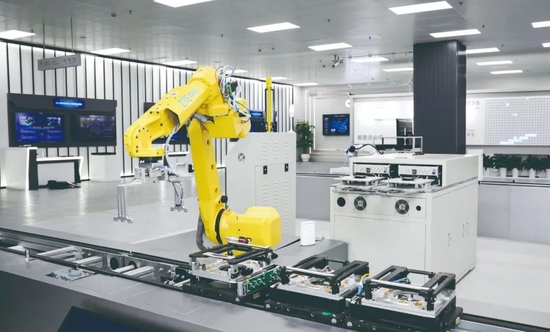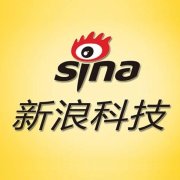 On July 22, 2022, ZTE exhibition area at the 5th Digital China Construction Achievement Exhibition. Figure/Vision China
On July 22, 2022, ZTE exhibition area at the 5th Digital China Construction Achievement Exhibition. Figure/Vision China By Xie Lirong and Wu Junyu
Editor/Mark
On July 5, 2018, Xu Ziyang, then the general manager of the core network product line of ZTE (000063.SZ/0763.HK, hereinafter referred to as ZTE) in Nanjing, received a notice from the headquarters that he would be appointed president of the company.
"I didn't expect it to be me at all," Xu Ziyang recalled in an exclusive interview with Caijing on October 10, 2022.
In March 2018, the news had spread inside ZTE: the US government was about to activate the sanctions order issued two years ago for ZTE's violation of the US import and export regulations, but many employees did not realize the seriousness of this news, because a similar incident had been experienced before, but it was successfully resolved, and it was generally believed that it could also be resolved this time.
Xu Ziyang also felt that it could be solved. What he did not expect was that the management at that time would leave collectively.
On the evening of April 16, the rumor came true, and the US Department of Commerce announced the launch of a refusal order against ZTE, which was valid for seven years. The refusal order is the highest level sanctions tool of the US Department of Commerce, and its influence is far greater than the list of entities it often uses.
The physical list prohibits upstream suppliers from selling specific items to the manufacturers on the physical list. Generally, it includes products originating in the United States and products made in foreign countries with more than 25% of the controlled ingredients in the United States. Due to the development of the global supply chain, in fact, non US origin products and products with controlled ingredients in the US accounting for no more than 25% are widely available, and the actual lethality of the physical list is not as great as people think.
The impact of refusal orders on enterprises in the supply chain field is similar to kicking financial enterprises out of the swift system. The launch of this refusal order was almost a disaster for ZTE at that time.
On July 14 of that year, after ZTE paid a fine of $1 billion and a deposit of $400 million, replaced all members of the board of directors and dismissed the company's senior management, the US government lifted the ban, and ZTE gained a glimmer of life.
Founded in 1985, ZTE is the second largest telecommunications equipment manufacturer in China and the fourth largest in the world. In 2017, the company had about 75000 employees, with an operating revenue of 108.82 billion yuan and a net profit of 5.39 billion yuan (about 820 million dollars), which was also the highest performance of the company before being sanctioned by the U.S. government.
Along with Xu Ziyang, there are more than 20 other key members of the original company. These "novices" who have no overall operating experience of the company have taken over a behemoth whose cash flow has lost blood and business has almost stopped due to huge fines. At that time, the outside world generally predicted that the company would collapse and even withdraw from the business stage.
"The whole person was deceived." Xu Ziyang recalled how he felt when he took over as president.
Four years later, ZTE has not disappeared. The financial report shows that ZTE's revenue in 2021 will be 114.5 billion yuan, and its operating profit will be 8.68 billion yuan, more than that in 2017, which will be the highest revenue and profit year of the company in the past decade.
But, What has ZTE experienced in the past four years and how did it rise from the dead? ZTE fell into crisis at the beginning of the Sino US Cold War in science and technology. Since the Cold War has deepened step by step, what enlightenment does ZTE's experience have for other Chinese companies?
From July to October 2022, Caijing reporter interviewed many senior executives, middle managers and grass-roots employees of different departments and lines, including Xu Ziyang, in an attempt to record the history of ZTE.
Dangerous self rescue
ZTE recovered much faster than expected after coming out of the ICU
On June 29, 2018, according to the agreement with the US government, 14 directors and management of ZTE left their posts collectively.
In the new leadership, the chairman of the board is Li Zixue, the former party secretary and deputy director of Xi'an Microelectronics Technology Research Institute of China Aerospace Science and Technology Group. Xi'an Microelectronics Technology Research Institute has a deep relationship with ZTE. Hou Weigui, the founder and former chairman of ZTE Communications, was the technical backbone of the Institute. ZTE Communications was founded when he was the head of the technical section.
Xu Ziyang was later informed that he would be appointed as the new CEO. Xu Ziyang joined ZTE in 1998 as a research and development technology post. After 24 years in ZTE, he has not only product research and development and business background, but also experience in international marketing and operation of overseas subsidiaries. Looking back later, this may be the main reason why he was selected.
Xu Ziyang and 21 other new senior executives took office without any handover with the previous senior executives.
Most of the 22 members of the new leadership team came from the original three level management cadres of ZTE, who were former vice presidents in charge of business fields (such as research and development, marketing, production, engineering, etc.) or professional fields (finance, law, etc.), and had been in the front line for a long time. In ZTE, the first tier is the board members including the president, the second tier is the executive vice president (EVP) and senior vice president (SVP), and vice presidents such as the general manager of the product line belong to the third tier.
But obviously, even if the professional ability is excellent, as a company leader, the new team is still slightly immature and inexperienced.
On July 12, the day when the agreement with the US government was announced, a group photo of the new team spread to the social network, because the smile, criticism and ridicule in the photo came like a tide.
Xu Ziyang has no time to study online comments. It took three months from the initiation of the ban to the lifting of the ban. ZTE's cash flow for normal operation in one month was more than 10 billion yuan. The longer the delay, the more serious the company's blood loss. The urgent task of the new team is to bring ZTE back from the life and death line, which has lost a lot of financial blood and has nearly stopped its business.
On May 17, 2019, the Ministry of Industry and Information Technology issued 5G licenses to three major telecom operators in China at the same time. Five months later, the three major telecom operators will carry out the first round of 5G equipment centralized purchase. According to the practice, the centralized purchase test will be completed more than one month before the bidding. For ZTE, this centralized purchase is a matter of life and death.
The prerequisite for participating in the bidding is that the equipment passes the test, and the self-developed chip is the key. 2019 is the first year for domestic operators to deploy 5G networks on a large scale. Mobile 160MHz and Telecom Unicom 200MHz are both ultra large bandwidth, requiring very high performance and energy efficiency of products. Whether ZTE's new generation chips can be commercially used on time with quality guaranteed directly determines the success of centralized procurement.
Generally speaking, it takes 18 to 24 months from design to commercial use to use high-performance chips in communication networks. Before being sanctioned, ZTE's R&D rhythm of chips and products matched that of operators' centralized procurement, The emergencies in 2018 delayed ZTE's process for six months.
A ZTE core personage revealed to the reporter of Finance and Economics that once the ban was issued, a very important decision-making level of the cooperative company believed that ZTE was definitely hopeless this time. No matter how ZTE explained and retained, the other party dismissed the support team stationed in ZTE at the first time. After the design of this batch of chips stagnated, the subsequent process also stagnated, and even the scheduled TSMC capacity was canceled.
ZTE's new management must seize back the lost time, and the chip can only be successfully rolled out in one version. Only in this way can the product be launched according to the original schedule, catch up with the operator's bidding, and there is no difference in the whole process.
The result was good. ZTE snatched back the time. The first version of the key streaming link was successful, and the third-generation chips and 5G products were commercially available as scheduled, gaining the expected market share in the first phase of the bidding.
ZTE's management reviewed afterwards that the support of old customers on project time and payment collection, the unswerving efforts of most suppliers, and the R&D foundation accumulated over many years have provided ZTE with enough guarantee to make every effort.
2018 is the darkest year in ZTE's history. In that year, the company's revenue was 85.51 billion yuan, a year-on-year decrease of 21.4%, and its net profit was -6.95 billion yuan, a year-on-year decrease of 229%. But in 2019, ZTE returned to the side of life and death. In 2019, ZTE achieved a revenue of 90.74 billion yuan, up 6.1% year on year, including 66.58 billion yuan of operator network revenue, up 16.7% year on year; The net profit was 5.15 billion yuan, up 173.7% year on year.
Financial data in 2019 showed that ZTE recovered much faster than expected after being launched into ICU.
These two years have been ZTE's most difficult years, but even in the months when its cash flow was on the verge of breaking, ZTE did not lay off workers, and did not default on employees' wages and suppliers' payment for goods.
The value of "red line"
"It's good that compliance can protect value. How can you say compliance can create value?"
After 2020, ZTE's vital signs began to stabilize, but Xu Ziyang and the core management knew that if they wanted to surpass the peak in 2017, the company must live to the death, solve the previous problems, and thoroughly reform.
The first step is to update the compliance risk control system. The overseas market contributes about one third of ZTE's revenue every year. To do business in various countries, we must abide by the laws and regulations of each country. The essence of compliance is to understand and comply with laws and regulations.
ZTE's previous project risk control was mainly manual supervision by the senior management. For example, when the contract amount reached a certain amount, the senior management, even the founder Hou Weigui himself, would participate in project process control and risk control, but this could not form a regular mechanism covering all projects.
Since 2019, ZTE has increased its investment and started to build a digital compliance system. The advantage of this system is that it can realize online flow and process visualization of compliance processes, and improve efficiency, quality and experience. The data middle office system is connected with the business and compliance main system, which can timely measure risks, monitor and warn, and strive to achieve compliance control when employees at all levels feel low and indifferent.
At the same time, ZTE attaches unprecedented importance to risk compliance and internal control, and regards talent, compliance and internal control as the cornerstone of its business development. ZTE has established a risk oriented compliance management system covering four aspects: rules, implementation, security and supervision.
In cooperation with the above measures, ZTE has also set up three lines of defense for compliance risk control. Compliance audit, as the last link of compliance closed-loop management, identifies compliance management loopholes, discovers residual risks, and promotes the spiral rise and dynamic adjustment of the entire compliance system.
ZTE also advocates the establishment of a violation reporting system by all employees, which can avoid the past practice: grass-roots employees complain, but when senior managers like Xu Ziyang complain, they stop complaining.
Although it was a bloody fall in compliance this time, ZTE has more than 70000 employees. Many people still do not feel the value of compliance after years of operating inertia.
Xie Junshi, ZTE COO (Chief Operating Officer), was deeply involved in the establishment of this compliance system. He said, "A few years ago, the company said that 'compliance creates value', but many people didn't understand it. They thought that 'compliance can protect value' was good. How can compliance create value?"
A number of ZTE employees confirmed this statement to the reporter of Caijing. Some people think it is understandable that such a compliance system has been built at great effort and cost. After all, it is a stumble; Some people think that during the crisis, it is better to spend energy on the place where it is easier to make achievements; Others think that compliance has nothing to do with most employees.
After several years of compliance building, compliance has been widely recognized and become a habit, because the benefits of compliance are constantly verified in the actual business process.
Like most Chinese enterprises, ZTE did not have a clear compliance "red line" before 2018, and the specific executors often chose two actions:
-
Either stay away from the "red line" and self impose restrictions on the understanding of fuzzy rules. The advantage of doing so is to stay away from "violations", and the disadvantage is that many opportunities will be lost;
-
Or ignore the "red line". For enterprises, this action may help them get orders, but the probability of violation is very high and the risk is very high.
"After the establishment of the compliance system, when I met a customer, I first scanned the internal system to see whether it was on the blacklist, whether it could be contacted, what the compliance line was, and what needs attention." An overseas employee of ZTE told Caijing that there was this "red line", "Know where the bottom line is, above the bottom line, and get the list as far as possible, but not beyond the red line".
Xie Junshi said that after 2018, ZTE's reputation in overseas markets has improved, because everyone knows that ZTE has built a reliable compliance system.
2018 is known as the first year of Chinese enterprise compliance. After the ZTE event, many large and medium-sized enterprises began to build a compliance system. Before that, they did not realize the importance of compliance, and few Chinese enterprises really achieved compliance management.
An external expert familiar with international trade and export control told Caijing that the United States has obvious advantages in technology and comprehensive national strength, and it has the strength to unilaterally control foreign enterprises. In this case, Chinese enterprises must be familiar with the relevant rules, find ways to solve problems, and avoid greater losses.
In the "class committee", specialty is more important than authority
The two existing institutions, the Operating Committee and the Professional Committee, have received unprecedented attention
As one of ZTE's most powerful people, Xu Ziyang told Caijing that compared with previous leaders, the new leadership has a big gap in insight, experience, authority and personal charm. From the beginning, the management team formed an atmosphere of brainstorming, "It's a bit like the class committee. I'm the monitor and discuss things together.".
Xu Ziyang believes that "authority" is really not so important. Open mind and enough humility can make the perspective more diverse, information more comprehensive, and thinking logic more scientific.
As an important decision, the typical ZTE style before was to find the most trusted "general" to focus on consulting opinions, refer to the opinions of the group, and ultimately perhaps the most important one or two people to make decisions.
The new team hopes to make up for its shortcomings with collective wisdom. It is more important to think about stability than speed. ZTE's two existing institutions have received unprecedented attention. One is the operation committee covering the core of power, and the other is 20 professional committees involving specific businesses.
ZTE has always had the tradition of setting up an operating committee, which is responsible for providing support for the president's decision-making. It is the advisory body of the board of directors of the company, and implements major business and investment decisions within the scope of authorization of the board of directors. The members include Chairman Li Zixue, President Xu Ziyang, and four EVPs (Executive Vice Presidents), including CHO (Chief Human Resources Officer) Gu Junying, COO Xie Junshi, CTO (Chief Technology Officer) Wang Xiyu, and CFO (Chief Financial Officer) Li Ying, who manage money. In addition, there are some SVP (Senior Vice President) members present.
When encountering major decisions, Xu Ziyang asked everyone in the Economic Commission to express their opinions, put forward solutions and be responsible for their own opinions. "You can't comment on a major decision with the attitude of an onlooker."
When differences are irreconcilable, Xu Ziyang needs to make a decision and be responsible for the final decision. Xu Ziyang said that there was almost no disagreement among the decision makers in difficult times. The year 2022 entered the transcending period of the strategic plan. When discussing the route to which ZTE would sail, the disagreement began to increase.
Xu Ziyang believes that it is normal to have differences, "everyone should open their minds, and moderate differences can make the perspective more comprehensive".
He recalled that when encountering differences, the management would adhere to front-line practice and repeated discussions, and the best way to reach a big consensus was to continue to achieve small successes.
ZTE has three business segments: operator network, government enterprise business and consumer business. The operator network business (i.e. telecom equipment business) accounts for 66.1%, which is the most profitable segment of ZTE. In 2021, the gross margin of this segment will be 42.5%. The other two business segments accounted for 11.4% and 22.5% respectively.
Telecom equipment business is also the cornerstone business of ZTE's three major businesses, which is listed as the first growth curve; IT server storage, data center, terminal (including smart home), government enterprise digitalization, automotive electronics and other innovative fields are listed as the second growth curve.
ZTE's decision makers have almost no differences on the development path of telecom equipment business.
The government enterprise business is the smallest of ZTE's three major businesses, but ZTE's decision makers have no differences on this business. They believe that with the advancement of the digital economy, it will become the most important revenue engine in the future.
The debate focused on terminal services.
In the terminal market, ZTE has performed well in broadband connections, access terminals, home smart devices and other products, while providing customized mobile phones for overseas telecom operators.
The revenue of terminal business is not poor, and the annual revenue growth rate is more than 40%, which makes ZTE's new generation of decision makers place high hopes on this business. However, ZTE mobile phones have almost no sense of existence in the domestic mass market, no universally recognized flagship mobile phones, and no brand and channel advantages.
Xu Ziyang believes that the comprehensive layout of terminal, management and cloud is conducive to the development of ZTE in the next decade. From this perspective alone, ZTE must support the growth of terminal business. He hoped ZTE could take out high-end mobile phones representing its strength and enter the list of domestic first-line players.
After the consensus, ZTE's mobile phone business has undergone major changes, such as a change of talents and direction.
For the cutting-edge track, Xu Ziyang's principle is: "Don't do gimmicky new business. It will be like cigarettes. After smoking, it will have side effects, waste resources, and make investors have unrealistic expectations of you."
This principle has avoided many subsequent disagreements.
Xu Ziyang said, "The biggest challenge is to reach a consensus on what not to do, especially when facing tuyere products."
"Do you want to do VR and AR virtual reality? Do you want to do something about the fashionable concept of the meta universe? Do you do some key applications in digital infrastructure? Do you want to be an alliance? Should resources in traditional industries be transferred? What should we do? " Xu Ziyang said that a large number of opportunities are in front of us, and it is probably not that difficult to do so.
As far as the system is concerned, ZTE's decision to do a new business in recent years must first pass the special committee.
ZTE has 20 professional committees, such as the Strategy Committee, the Technical Committee, the Business Health and Safety Committee, the Cost Strategy Committee, the Human Resources Committee, and the Project Management Committee. These committees provide decision-making reference for the Economic Commission, but they must make "assertions" and not be ambiguous. They must give clear decision-making suggestions and how to do it. At the same time, the special committee should not be held responsible for "assertions". The assessment of the special committee is independent and professional.
A ZTE executive explained to the reporter of Finance and Economics that "the special committee can make judgments independently without being affected by the subjective intentions of leaders. After making judgments, the adoption right is above, and the risk is above, the special committee will become more professional."
"For example, if he (Xu Ziyang) put forward an idea that he could not support financially, technically, or human resources, he would cut it out in time," said the ZTE executive.
These efforts have indeed seen positive results. Some ZTE grassroots employees found that the company's direction was clearer, decision-making efficiency was higher, and things were simpler. Some people commented that "crisis is not all bad things."
Goal, desire and conservatism
After life and death, ZTE needs to become a more innovative company
On March 22, 2022, ZTE received a judgment from the US court, ruling that ZTE's probation period expired without any additional punishment, and confirmed that the term of office of the Ombudsman would end on March 22 (US time).
On the same day, the term of office of the Ombudsman appointed by the United States Court ended. This means that the five-year supervision of ZTE by the US Department of Justice is over. Although the 10-year supervision period of the U.S. Department of Commerce is still six years away, However, the departure of the inspectors is generally regarded as a phased victory of ZTE, which is conducive to its long-term development.
In March 2022, Li Zixue, chairman of ZTE, made his first statement to the outside world that ZTE's goal is to enter the Fortune 500. This is a list of the world's largest 500 companies ranked by Fortune magazine based on their annual revenue.
The 500th place in the Fortune 500 in 2022 is Youmeike, which will have a revenue of 28.65 billion US dollars in 2021 and a revenue of 114.5 billion yuan in 2021. According to the exchange rate of that year, the difference between the two companies is about 90 billion yuan.
This goal is somewhat radical, but it is not impossible to achieve. ZTE has its own advantages. Under the wave of digital economy, the digital business of government and enterprises has huge growth space. ZTE's current revenue mainly comes from communication equipment (CT), but its advantages in IT products are extending to more market areas. Servers, storage, data centers and related data communication products have entered the high-speed growth channel. ZTE has also begun to fully enter the fields of industrial digitalization, smart home, digital energy, automotive electronics, etc.
 ZTE Binjiang Global 5G Intelligent Manufacturing Base Mulong Laboratory
ZTE Binjiang Global 5G Intelligent Manufacturing Base Mulong Laboratory Xu Ziyang again emphasized the importance of terminal services in the new goal. ZTE plans to take mobile phones as the core, form a "1+2+N" development pattern around personal data, home data and smart peripheral ecological products, increase the expansion of consumption channels, and strive to make terminals become another strong engine driving performance growth.
The key factor to achieve the new goal is the support of ZTE's talents and organizations.
In 2022, ZTE released 5000 new graduates, most of whom are R&D and technical posts. This year, against the background of general layoffs in large enterprises, ZTE did not cut jobs. The management also gave employees, especially key technical staff, a large salary increase.
ZTE executives told Caijing that the company now prefers compound "digital intelligence" talents. Through various mechanisms, the decision-making layer encourages the cultivation of new era trendsetters and slash youth with "scenario based customer thinking", "cross domain integration thinking", "agile thinking", etc. "Do not want to be the technical homeboy who is immersed in technology, research and development, and engineering in everyone's impression, and the company needs to become cooler and more dynamic in the future".
It is not easy to fight against organizational inertia. ZTE's successful thinking as an operator market for decades is good planning, strong execution and high efficiency, just like a machine that fits perfectly. Now, digital business and terminal business are facing a fully competitive market, which requires organizations to become faster and more agile.
The crisis event in 2018 has promoted ZTE to accelerate its organizational evolution, and the results have been shown. How far it will go is still unknown.
"This is really the biggest challenge at present," said Xu Ziyang. ZTE needs to transform from a mechanical organization with "strong execution and planning" into a biological organization with "strong flexibility and self evolution". These are two completely different species, but "there is no need to worry, face the reality and take the initiative to change".
The external environment is still changing. On November 25, Eastern Time, the Federal Communications Commission (FCC) announced that in order to protect the U.S. communications network and establish a more secure and flexible supply chain, it is prohibited to sell communications and camera equipment that pose unacceptable risks to national security in the United States.
The five Chinese companies named by the FCC are Huawei, ZTE, Hytera, Hikvision, Dahua Technology and its subsidiaries and affiliates.
The FCC has previously prohibited the use of subsidies from the US federal government to purchase the equipment and services of the five Chinese companies, which completely blocked their sales windows in the US market.
However, the new ban has limited lethality to ZTE, and the proportion of American business in ZTE's overall revenue is less than 1%.
ZTE responded to Caijing that ZTE strongly opposed the FCC's decision and was evaluating feasible legal means to safeguard legitimate rights and interests. In view of the current market environment in the United States, the company will gradually withdraw from the American market and focus on other markets with more growth potential.
Since 2022, Xu Ziyang has become less busy. Looking back on the two years of 2018 and 2019, he was almost always baking on the fire. He changed his habit of paying attention to specific matters and watching the progress of subordinates' implementation, instead, he spent half of his time traveling on business and hanging out with customers. He began to care about ZTE's image in the eyes of customers - is it competitive or not? How was the service? Is social responsibility in place? Compared with the first three years as president, he is more willing to look at this company in a place far away from ZTE.
"Having experienced life and death, I have nothing to tangle with now," Xu Ziyang told Caijing.






























